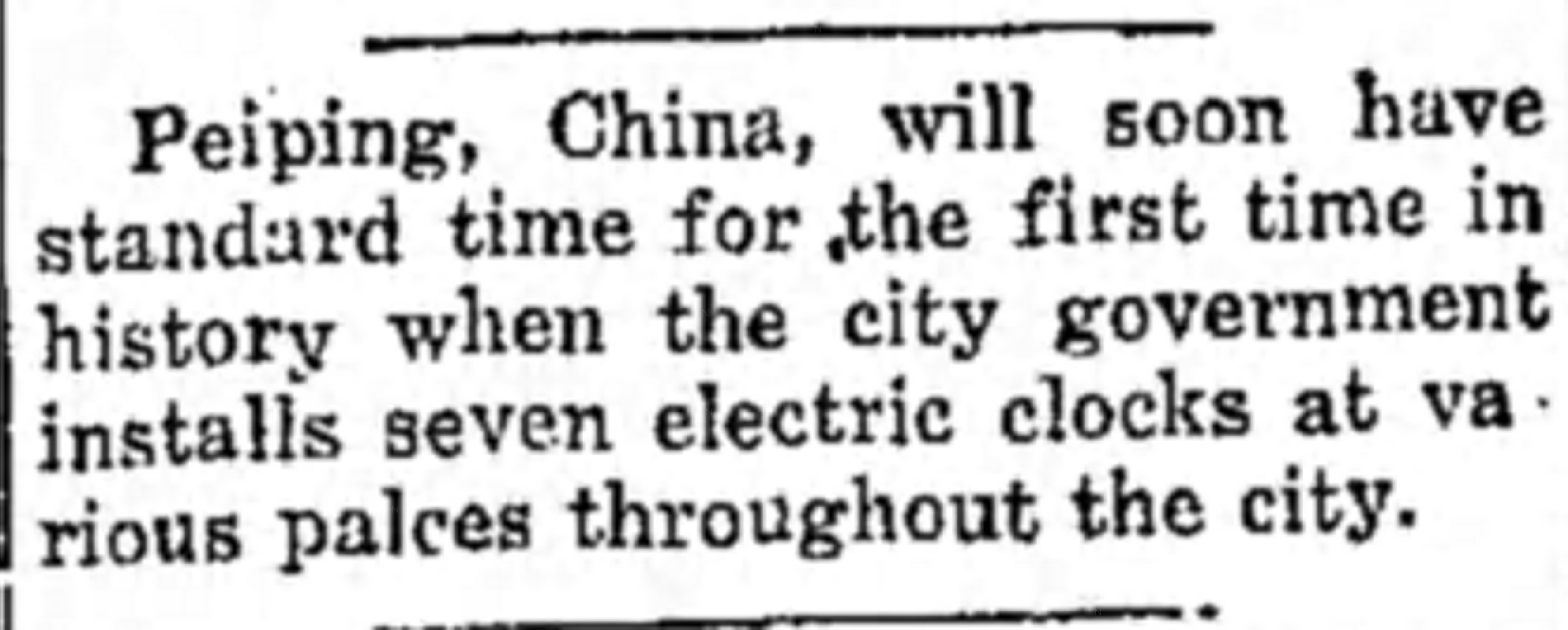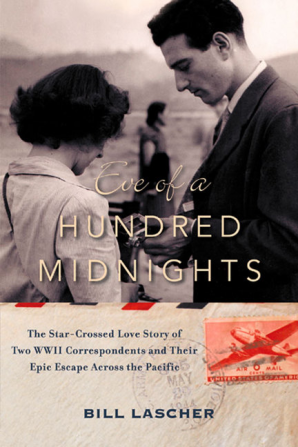Posted: November 8th, 2016 | No Comments »
Until January 1937 Peking (Beijing, if you prefer) had no standard time. Of course there was a set time but very few clocks agreed and some people relied on gongs during the night, a cannon shot at noon and other forms of timekeeping. However, with the treaty ports having introduced standard time through electric clocks (and also Nanking, the capital) Beijing decided to get modern too. Additionally standard time would be a great help to train, bus, trolleybus and, just starting for Peking, flight timetables. And so seven electric clocks were installed in the city to allow people to set their own watches and clocks by these.
Nanjing had bought a KS Clock from Germany (I have seen this written but can find no trace of K.S. clocks) in 1929 which sent out a time signal at noon and 6pm each day for people to synchronize with. The National Astronomical Observatory had been opened in 1912 in Beijing and did answer telephone queries about the time – a sort of personalised Speaking Clock.
Maybe someone knows the following – what clocks did Peking use and where were the seven timepieces located?

Posted: November 7th, 2016 | No Comments »
A friend recently strolled down Armour Factory Alley in Beijing, now Kujiachang Hutong. It was of course where both the Werners (from my book Midnight in Peking) as well as Edgar and Helen Foster Snow lived….The latter courtyard house is gone; Werner’s remains (though intensely sub-divided). Anyway, at least it survives amazingly….





Posted: November 5th, 2016 | No Comments »
Another post somewhat related to my article in the current issue (No.8) of The Cleaver Quarterly on London’s Chinese restaurant scene in the 1930s and 1940s. Very interesting to me was M.P. Lee’s 1943 book, Chinese Cookery: A Hundred Practical Recipes. Useful ways to cook Chinese food during the Blitz and having to survive on the ration!
MP Lee enlisted the great British-based Chinese artist and poet Chiang Yee, famous for the Silent Traveller series of books, to provide the illustrations (or “decorations” as they rather charmingly called them). Of course you should order or buy the magazine to read the entire article and see all the illustrations, but here are a sample…





Posted: November 4th, 2016 | No Comments »
I’ve blogged before about Bill Lascher’s Eve of a Hundred Midnights, the biography of Mel and Annalee Jacoby, two of the finest correspondents to cover wartime China. Of course they had both long interested me from the time I wrote a history of the foreign press corps in China from the 1830s to 1950s, Through the Looking Glass. Recently I got to fire a few questions at Bill about the book and its subjects – while Mel is interesting to me I must admit that I’ve also been long fascinated by Annalee Jacoby (who co-authored the WW2 best seller Thunder Out of China with Theodore White) and feel (as i mentioned recently when talking about Helen Foster Snow, wife of Edgar and a great writer in her own right) she’s been seriously overlooked.
Anyway, here’s my Q&A with Bill Lascher in the Los Angeles Review of Books China Blog….

Posted: November 3rd, 2016 | 1 Comment »
The Mih-Ho-Loong Cocktail was made famous in 1930s Shanghai by the men of A Company of the Shanghai Volunteer Rifles, also known as a the Mih-Ho-Loong Rifles. The Company had been formed in 1870 when the Hook and Ladder Company (firemen) and the Mih-Ho-Loong Rifle Company were one and the same outfit. They split in 1879 though A Company Riflemen were invariably also volunteer firemen. They morphed into A Company of the Shanghai Volunteer Corps with a mostly British membership in the 1930s.
 A Mih-Ho-Loong helmet plate encompassing the crossed firemen’s ladder and rifle
A Mih-Ho-Loong helmet plate encompassing the crossed firemen’s ladder and rifle
And, Shanghai being Shanghai, they had their own preferred cocktail – the Mee-Ho-Loong:
Half fill a glass with broken ice and add:
1 dash orange bitters
a quarter gill sloe gin
eighth gill of French Vermouth
I’ve recreated it using my own home-made sloe gin:


Posted: November 2nd, 2016 | No Comments »
You can of course still stay in the Astor House Hotel in Tianjin – I wouldn’t stay anywhere else. They gave it a makeover a few years back which didn’t help thinks heritage wise (though was outstanding by Chinese standards that range from Bulldozer to Terrible). I stayed there quite a few times in the 1990s when it felt very ghost like and it wasn’t always obvious it would escape the demolition man. It is, of course, wonderfully situated close to the former Victoria Park and the river. I won’t go into the history of the hotel here – too long (1846) and easy enough to find in books or on the internet.

Posted: November 1st, 2016 | No Comments »
On October 31 1916 recruitment of Chinese men for the British Chinese Labour Corps (CLC) began in Weihaiwei. The War Office in London had appointed a former railway engineer, Thomas J. Bourne, to the job of organising the recruitment centre. Bourne (1864-1947) had been Engineer-in-Chief on the Peking-Hankow Railway. He’d been in China nearly 30 years when asked by the government to organise the recruiting of the CLC. Bourne was based in Peking but made the three day journey to Weihaiwei to set up the recruiting station. He arrived and began work a century ago this week – October 31st. The recruitment camp they built in Weihaiwei is shown below.
Bourne’s assistant was Theodore Roberts, a chartered accountant. The day-to-day administration of the Labour Depot (where the recruited men were camped until shipped to Europe) was handled by G.S. Moss who worked in the British Consular Service. Moss had been stationed in a number of small treaty ports including Pakhoi. He went on to become British Consul in Weihaiwei and Canton (Guangzhou) after the war. Moss was considered a good linguist and got a CBE. Moss stayed involved through till 1919 and the demobilisation of the CLC.


Posted: October 31st, 2016 | No Comments »
I blogged a relocation ad from 1940 for Shanghai tailors Old Bond Street quite a while ago. And now my thanks to Bill Savadove in Shanghai who unearthed this ad of theirs from 1939.
There’s a few interesting things about this ad. Old Bond Street was run by Erwin Leschziner, a Jewish refugee tailor and dress designer, who came to Shanghai to escape the rise of the fascism. He employed some other Jewish tailors in the business – so his claim to branches in Berlin and Wien (Vienna) are more sort of where they came from than where they had stores (Jewish stores not being too popular in 1939 in either of those cities!!). He did have a store in Shanghai and they did do fittings in the Cathay Hotel though.
 Next, His Highness the Maharaja of Kapurthala (in the Punjab), better known perhaps as Jagatjit Singh (1872-1949). He became the Maharaja as a young boy, in 1877 (assuming full ruling powers in 1890) and ruled till the end of his life. He was a Francophile and constructed palaces and gardens in Kapurthala based on Versailles. Despite this he was a serious man, acting as the Indian representative at the League of Nations in the 1920s and becoming a hard core world traveller. He also did visit Shanghai – there’s pic here of him with the local Sikh community in the 1930s. One presumes the ‘ladies dresses’ were not for him but for his retinue (the Maharaja of Kapurthala travelled with a large female retinue apparently – back in the early 1900s he’d managed to annoy the Japanese by visiting Tokyo and “adding” two Japanese women to his travelling party).
Next, His Highness the Maharaja of Kapurthala (in the Punjab), better known perhaps as Jagatjit Singh (1872-1949). He became the Maharaja as a young boy, in 1877 (assuming full ruling powers in 1890) and ruled till the end of his life. He was a Francophile and constructed palaces and gardens in Kapurthala based on Versailles. Despite this he was a serious man, acting as the Indian representative at the League of Nations in the 1920s and becoming a hard core world traveller. He also did visit Shanghai – there’s pic here of him with the local Sikh community in the 1930s. One presumes the ‘ladies dresses’ were not for him but for his retinue (the Maharaja of Kapurthala travelled with a large female retinue apparently – back in the early 1900s he’d managed to annoy the Japanese by visiting Tokyo and “adding” two Japanese women to his travelling party).
In 1939 by the way the Maharaja was 67. He was also preparing for war and had publicly offered all his troops and resources to the service of the British Empire. He had assumed the rank of Colonel. He passed through Shanghai (and Singapore) on his way to visit the Golden Gate Exposition in San Francisco, travelling on the rather luxurious Lloyd-Triestino line the Conte Biancamano. He visited Shanghai with his second son, Prince Amarjit Singh, who was at the time the officer in charge of all Punjab armed forces.




















